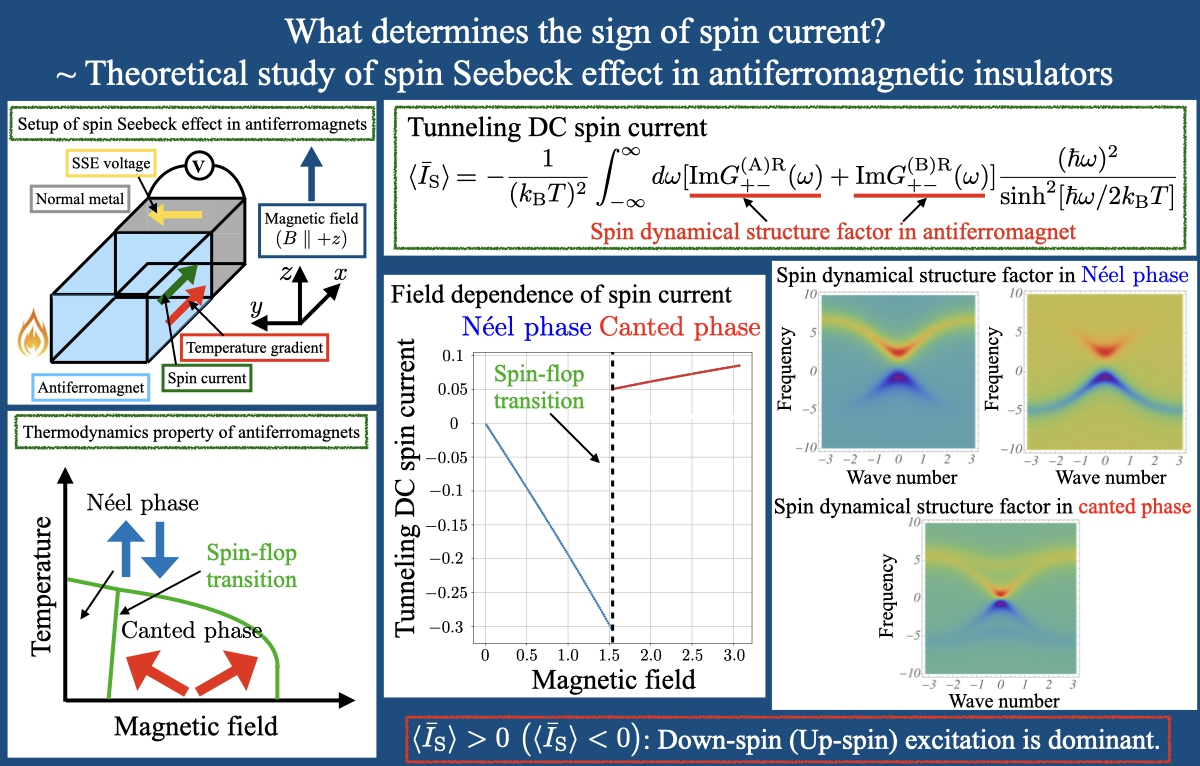What Determines the Sign of Spin Current? ~ Theoretical Study of Spin Seebeck Effect in Antiferromagnetic Insulators
© The Physical Society of Japan
This article is on
Microscopic Theory of Spin Seebeck Effect in Antiferromagnets
(JPSJ Editors' Choice)
J. Phys. Soc. Jpn. 93, 034702 (2024).
We developed a microscopic theory for the spin Seebeck effect in antiferromagnets, that explains the sign reversal of the spin current at the spin-flop transition point and describes the sorts of dominant carriers.

The spin Seebeck effect (SSE) is an established method for generating a DC spin current using a temperature gradient. In the standard experimental setup, a temperature gradient is applied to a bilayer junction of a target magnet and a metal; the gradient direction is perpendicular to their interface. The generated spin current runs along the gradient in the magnet and is injected into the metal, where it is converted into an electric voltage via the inverse-spin Hall effect. Because the spin current is essentially non-conserved and almost impossible to directly detect, attachment of a metal is necessary to (indirectly) observe the spin current as an electric signal.
Since its discovery in 2008, the SSE has been explored in various magnetic materials including antiferromagnets, which are one of the most fundamental magnetic materials and have garnered attention as a new platform for ultrafast spintronics because their magnetic excitations (magnons) reside in a higher-energy THz regime than magnons in ferromagnets. Thus, it is important to understand the nonequilibrium phenomena in antiferromagnets, including the SSE. Most theoretical research on SSE in antiferromagnets relies on phenomenological arguments; thus, development of microscopic understanding is desirable.
Based on spin-wave theory and the non-equilibrium Green’s function approach, we analyze the DC spin current flowing from the antiferromagnet to the attached metal. We determine the relationship between the spin current and the inelastic neutron scattering spectrum. The tunnel spin current is expressed with dynamical spin structure factors that are proportional to the density of states of spin-current carriers and can be measured by inelastic neutron scattering. Our analysis shows that the sign of the spin current is determined by the spin polarization direction of the dominant carrier and that the sign reverses at the spin-flop transition point. This result is in agreement with a recent SSE experiment on Cr2O3. Furthermore, our theory predicts that in a low-temperature regime, the spin current in the canted phase exhibits a non-monotonic field dependence, which could be potentially observed in future experiments.
In addition to these predictions, our microscopic theory makes it possible to quantitatively compare the SSE of antiferromagnets with those of other magnets. Such a quantitative comparison is difficult within the phenomenology, which is an advantage of our microscopic theory.
Development of microscopic theories generally deepens the understanding of observed phenomena and helps predict new related phenomena. Our findings are expected to contribute to understanding the SSE in antiferromagnets and unexplored non-equilibrium dynamics in future spintronics and non-equilibrium physics.
Written by K. Masuda and M. Sato.
Microscopic Theory of Spin Seebeck Effect in Antiferromagnets
(JPSJ Editors' Choice)
J. Phys. Soc. Jpn. 93, 034702 (2024).
Share this topic
Fields
Related Articles
-
Discovery of Light-Induced Mirror Symmetry Breaking
Dielectric, optical, and other properties in condensed matter
Electronic transport in condensed matter
2024-9-2
The authors discovered the light-induced mirror symmetry breaking, paving the way for controlling mirror symmetries via light and for realizing various phenomena utilizing the mirror symmetry breaking.
-
Discovery of Unconventional Pressure-Induced Superconductivity in CrAs
Superconductivity
Electronic transport in condensed matter
2024-8-13
A new study has discovered pressure-induced superconductivity in the helimagnet CrAs, originating in the vicinity of the helimagnetic ordering, representing the first example of superconductivity in Cr-based magnetic systems.
-
Antiferromagnetism Induces Dissipationless Transverse Conductivity
Electronic transport in condensed matter
Magnetic properties in condensed matter
Electronic structure and electrical properties of surfaces and nanostructures
2024-7-24
An investigation using high-quality NbMnP crystals demonstrates that the anomalous Hall conductivity arising from antiferromagnetism is dissipationless, as expected from the intrinsic mechanism.
-
Exploring Electronic States in BEDT-TTF Organic Superconductors
Superconductivity
Electronic transport in condensed matter
Magnetic properties in condensed matter
2024-4-24
This review, published in the Journal of the Physical Society of Japan, provides a comprehensive summary of the electronic states observed in BEDT-TTF type organic superconductors, including metal-insulator transitions, Mottness transitions, non-Fermi liquids, quantum spin liquids, and Bose-Einstein condensation.
-
Conversion of Chiral Phonons into Magnons in Magnets
Electronic transport in condensed matter
2024-4-1
A new phenomenon involving the conversion of chiral phonons into magnons is theoretically predicted. The effective magnetic field induced by chiral phonons causes a change in the spin magnetization of magnets.
